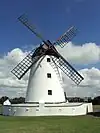| St Cuthbert's | |
|---|---|
 | |
 St Cuthbert's Location in Lytham St Annes | |
| 53°44′15″N 2°58′34″W / 53.7374°N 2.9762°W | |
| OS grid reference | SD 357 272 |
| Location | Lytham, Lancashire |
| Denomination | Anglican |
| Website | St Cuthbert, Lytham |
| History | |
| Status | Parish church |
| Architecture | |
| Functional status | Active |
| Heritage designation | Grade II* |
| Architect(s) | W. H. Hobden Paley and Austin Austin and Paley |
| Completed | 1834–1835 |
| Administration | |
| Province | York |
| Diocese | Blackburn |
| Archdeaconry | Lancaster |
| Deanery | Kirkham |
St Cuthbert's is an Anglican church in Lytham, Lancashire, England. It was built 1834–1835, replacing a previous church on the same site. It is an active parish church in the Diocese of Blackburn. Since 1971 it has been designated a Grade II* listed building.
History
The current church is the third to be built on the site. A church was built in 1770, replacing an older structure of cobbles.[1] The 1770 building was in turn replaced by the current structure, built in 1834–1835 to a design by W. H. Hobden.[1][2] It was enlarged in 1872 with the addition of a chancel by the Lancaster architects Paley and Austin.[3] In 1882 the same partnership added the north aisle, a vestry and the organ chamber,[4] followed by new seating and a new front to the gallery in 1887.[5] The church was further enlarged in 1909.[6] A memorial chapel was added in 1931 by the successors in the practice, Austin and Paley.[7] On 13 January 1971 the church was designated a Grade II* listed building.[6] The Grade II* designation is the second highest of the three grades.[8]
St Cuthbert's is an active parish church in the Diocese of Blackburn, the Archdeaconry of Lancaster, and the Deanery of Kirkham.[9]
Architecture
Exterior
St Cuthbert's is constructed of dark red brick with sandstone dressings in the Perpendicular style.[6] The roofs are slate. The plan consists of a west tower, a nave with aisles to the north and south, to the east, a chancel and a vestry north of the chancel.[1][6] There is a small porch at the west end of the south aisle.
The tower has diagonal buttresses and three stages.[6] Its parapet is crenellated.[2] It has two-light belfry louvres and a two-light west window. The aisles have three-light windows in the Perpendicular style and the nave clerestory has smaller two-light windows. There are two-light windows in the chancel and the east window is a large three-light window in the Arts and Crafts style.[6] Like the tower, the aisle, nave, porch and chancel walls are crenellated.[2]
Interior and fittings
The tower houses a ring of eight bells, hung in a wooden frame.[10] The church includes monuments to the local Clifton family.[1]
St Cuthbert's stained glass includes a window designed in 1860 by Hardman & Co., an 1874 window depicting the Mount of Olives by Morris & Co. as well as work by Charles Eamer Kempe, Jean-Baptiste Capronnier and Clayton and Bell.[2]
Churchyard and surroundings

Approximately 3 metres (9.8 ft) south-east of the church porch is a sandstone pedestal sundial, undated, but probably from the 18th century.[11] It has a gadrooned base with a fluted collar.[11] The plate and gnomon are copper and the plate is inscribed with "Dum spectes fugio".[1] The sundial has been given a Grade II designation from English Heritage.[11] The churchyard also contains the war graves of nine service personnel of World War I, and five of World War II.[12]
About 30 metres (98 ft) north of the church there is a monument to the crew of the St Annes-on-Sea lifeboat Laura Janet, who drowned in 1886 in an attempted rescue mission of the Mexico.[13] The monument is constructed of red sandstone and, 4 metres (13 ft) high, sits on a square plinth of two steps. It is carved with an image of the lifeboat and inscribed with the names of the lost crew members. The monument has also been given a Grade II designation.[13]
The vicarage to the west of St Cuthbert's may date from 1836, and may have been designed by W. H. Hobden.[2] It is constructed of red brick in Flemish bond with ashlar dressings in the Elizabethan style.[2] Some features are Jacobean.[14] The vicarage has been designated a Grade II listed building by English Heritage.[14]
See also
References
Citations
- 1 2 3 4 5 Farrer & Brownbill (1929), pp. 213–19
- 1 2 3 4 5 6 Hartwell & Pevsner (2009), p. 434
- ↑ Brandwood et al. 2012, p. 226.
- ↑ Brandwood et al. 2012, p. 233.
- ↑ Brandwood et al. 2012, p. 236.
- 1 2 3 4 5 6 Historic England, "Church of St Cuthbert (1196361)", National Heritage List for England, retrieved 6 April 2015
- ↑ Brandwood et al. 2012, p. 253.
- ↑ Listed Buildings, Historic England, retrieved 6 April 2015
- ↑ St Cuthbert, Lytham, Church of England, retrieved 21 June 2012
- ↑ Cheetham (1919), pp 61–63
- 1 2 3 Historic England, "Sundial Approximately 3 Metres South East of Porch of Church of St Cuthbert (1196362)", National Heritage List for England, retrieved 6 April 2015
- ↑ LYTHAM (ST. CUTHBERT) CHURCHYARD, Commonwealth War Graves Commission, retrieved 15 February 2013
- 1 2 Historic England, "Laura Janet Monument Approximately 30 Metres North of Church of St Cuthbert (1297684)", National Heritage List for England, retrieved 6 April 2015
- 1 2 Historic England, "Vicarage (1196363)", National Heritage List for England, retrieved 6 April 2015
Sources
- Brandwood, Geoff; Austin, Tim; Hughes, John; Price, James (2012), The Architecture of Sharpe, Paley and Austin, Swindon: English Heritage, ISBN 978-1-84802-049-8
- Cheetham, F. H. (1919), The Church Bells of Lancashire [Part 4: The Hundred of Amounderness], Sherratt & Hughes, OCLC 27475286
- Farrer, William; Brownbill, J., eds. (1912), "Lytham", A History of the County of Lancaster: Volume 7, OCLC 59626695
- Hartwell, Clare; Pevsner, Nikolaus (2009) [1969], Lancashire: North, New Haven and London: Yale University Press, ISBN 0-300-12667-0
External links
 Media related to St Cuthbert's Church, Lytham at Wikimedia Commons
Media related to St Cuthbert's Church, Lytham at Wikimedia Commons
